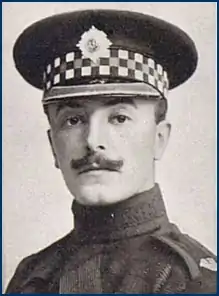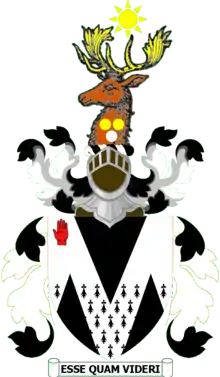Sir Edward Hulse, 7th Baronet
Sir Edward Hamilton Westrow Hulse, 7th Baronet (31 August 1889 – 12 March 1915) was an officer in the British Army during the First World War. He had his letters published posthumously detailing his account of the fighting on the Western Front, describing events such as the Christmas Truce.[1]

Biography
Born in Westminster to Lady Hulse, only daughter of Sir Edward Levy-Lawson, and Sir Edward Henry Hulse, 6th Baronet and a Conservative politician.[2] He succeeded to the title of baronet in 1903, after his father committed suicide.[3] He was educated at Eton College and Balliol College, Oxford, completing his degree reading History in 1912.[4]
After a period of training with the Coldstream Guards, he was given a commission in the 1st Battalion Scots Guards on 8 March 1913. In August 1914, after the outbreak of World War I in July, he went to Mons with the 1st Battalion. In November he was transferred to the 2nd Battalion.[1]
Sir Edward Hulse was killed in action at Neuve-Chapelle on 12 March 1915. According to a short biography written by Perceval Landon as an introduction to Hulse's collection of letters, his commanding officer, Major Paynter, fell severely wounded and Hulse was killed crossing open ground after trying to help him.[1]
Hulse's name can be found on the Salisbury war memorial,[5] as well as there being a plaque recording his death placed in Salisbury Cathedral, dedicated by the Bishop of Salisbury, on 11 March 1916.
 |
|
References
- Sir Edward Hulse (1916). Letters Written From the English Front in France between September 1914 and March 1915. Privately published.
- "Person Page". thepeerage.com. Retrieved 11 May 2016.
- Obituary of Sir Edward Henry Hulse. The Times, 1 June 1903, p. 4.
- Balliol College War Memorial Book, Vol 1. Oxford. 1924. pp. 282–283.
{{cite book}}: CS1 maint: location missing publisher (link) - "Citizens of Salisbury - WW1 and WW2 | WAR MEMORIALS ONLINE". warmemorialsonline.org.uk. Retrieved 12 May 2016.
- Burke's Peerage. 1949.